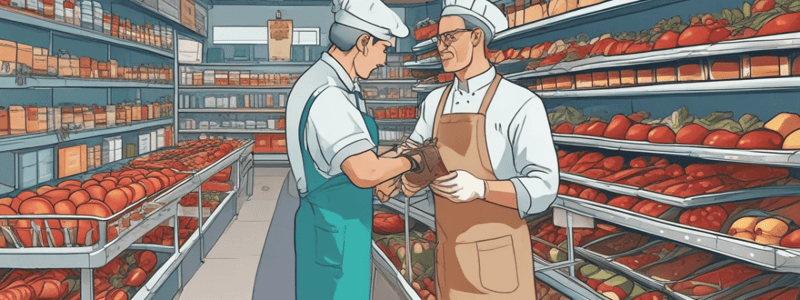Podcast
Questions and Answers
What is the primary purpose of this section?
What is the primary purpose of this section?
- To outline the general principles of food production
- To describe potential hazards and defects at individual processing steps (correct)
- To provide a detailed guide on HACCP and DAP analysis
- To specify critical limits and monitoring procedures
What is unique about bivalve molluscs species?
What is unique about bivalve molluscs species?
- They can survive for extended periods out of water and can be traded for human consumption as live animals (correct)
- They are not commonly consumed by humans
- They are always processed and never traded live
- They can only survive for short periods out of water
Why is it undesirable to trade bivalve molluscs as live animals after spawning?
Why is it undesirable to trade bivalve molluscs as live animals after spawning?
- Because they are no longer fit for human consumption
- Because they become more susceptible to microbiological contamination
- Because they become toxic
- Because it becomes impracticable to handle them (correct)
What is the main hazard known for the production of bivalve molluscs?
What is the main hazard known for the production of bivalve molluscs?
Why do molluscs concentrate contaminants to a higher degree than the surrounding seawater?
Why do molluscs concentrate contaminants to a higher degree than the surrounding seawater?
What determines the process requirements for further processing of bivalve molluscs?
What determines the process requirements for further processing of bivalve molluscs?
What can induce spawning in bivalve molluscs?
What can induce spawning in bivalve molluscs?
Why are some species of bivalve molluscs best handled as chilled products or processed?
Why are some species of bivalve molluscs best handled as chilled products or processed?
What is a potential source of contamination in agricultural runoff and sewage?
What is a potential source of contamination in agricultural runoff and sewage?
What is a type of serious poisoning that can be caused by biotoxins produced by some algae?
What is a type of serious poisoning that can be caused by biotoxins produced by some algae?
What type of pathogens can occur naturally in the environment?
What type of pathogens can occur naturally in the environment?
What is a potential hazard in certain areas, in addition to biotoxins and pathogens?
What is a potential hazard in certain areas, in addition to biotoxins and pathogens?
What is another type of serious poisoning that can be caused by biotoxins produced by some algae?
What is another type of serious poisoning that can be caused by biotoxins produced by some algae?
What type of poisoning is caused by azaspiracid (AZP)?
What type of poisoning is caused by azaspiracid (AZP)?
Flashcards are hidden until you start studying
Study Notes
Hazard Analysis and Control Measures
- Hazard Analysis Critical Control Point (HACCP) and Defect Action Point (DAP) plans require consultation with Section 5 for guidance on application principles.
- The scope of this Code does not provide details on critical limits, monitoring, record-keeping, and verification for each step, as these are specific to each hazard or defect.
Bivalve Molluscs
- Bivalve molluscs species, such as oysters, mussels, manila and hard shell clams, can survive for extended periods out of water and are traded for human consumption as live animals.
- Other species like cockles can be traded live if carefully handled, but are normally processed.
- Species not adapted to dry conditions soon die out of water and are best handled as chilled products or processed.
Hazards in Bivalve Molluscs Production
- The main hazard is microbiological contamination of the water in which they grow, especially when intended to be eaten live or raw.
- Molluscs concentrate contaminants to a much higher degree than in the surrounding seawater due to being filter feeders.
- Contamination with bacteria and viruses in the growing area is critical for end-product specification and determines process requirements for further processing.
Health Risks
- Gastro-enteritis and other serious diseases, such as hepatitis, can occur due to agricultural runoff and/or sewage contamination with enteric bacterial and/or viral pathogens.
- Hazards also include biotoxins produced by some algae, causing various forms of serious poisoning like diarrhetic shellfish poisoning (DSP), paralytic shellfish poisoning (PSP), neurotoxic shellfish poisoning (NSP), amnesic shellfish poisoning (ASP), or poisoning caused by azaspiracid (AZP).
- Chemical substances, such as heavy metals, pesticides, and organochlorides, and petrochemical substances may also present hazards in certain areas.
Processing Steps
- Relaying, processing to reduce or limit target organisms, classification, and monitoring of growing areas, harvesting, transportation, reception, washing/declumping/debyssing/grading, shucking/hand & mechanical shucking/heat shock, raw packaging and labelling, raw storage, and distribution/transportation are key processing steps.
Studying That Suits You
Use AI to generate personalized quizzes and flashcards to suit your learning preferences.




